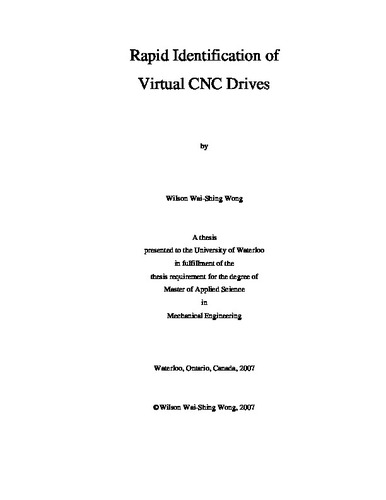| dc.description.abstract | Virtual manufacturing has gained considerable importance in the last decade. To obtain reliable predictions in a virtual environment, the factors that influence the outcome of a manufacturing operation need to be carefully modeled and integrated in a simulation platform. The dynamic behavior of the Computer Numerical Control (CNC) system, which has a profound influence on the final part geometry and tolerance integrity, is among these factors. Classical CNC drive identification techniques are usually time consuming and need to be performed by an engineer qualified in dynamics and control theory. These techniques require the servo loop or the trajectory interpolator to be disconnected in order to inject the necessary identification signals, causing downtime to the machine. Hence, these techniques are usually not practical for constructing virtual models of existing CNC machine tools in a manufacturing environment.
This thesis presents an alternative strategy for constructing virtual drive models with minimal intervention and downtime to the machinery. The proposed technique, named “rapid identification”, consists of executing a short G-code experiment and collecting input/output data using the motion capture feature available on most CNC controllers. The data is then processed to reverse engineer the equivalent tracking and disturbance transfer functions and friction characteristics of the machine. It is shown that virtual drive models constructed this way can be used to predict the real machine’s contouring performance for large class of drive systems, controlled with different control techniques.
In the proposed scheme, the excitation is delivered by smoothly interpolated motion commands. Hence, convergence of parameters to their true values is not guaranteed. When the real system contains pole-zero cancellations, namely due to feedforward control action, this also results in a loss of identifiability. In order to guarantee the stability of the identified drive models, the pole locations are constrained with frequency and damping ratio limits. Hence, the rapid identification task is cast as a constrained minimization problem.
Two solution strategies have been developed. In the first approach, Lagrange Multipliers (LM) technique is applied, which yields successful estimation results. However, implementation of LM is computationally intensive and requires the use of a dedicated symbolic solver. This limits the portability for industrial implementation. In the second approach, a Genetic Algorithm (GA) search technique is developed, which is a more practical but slightly approximate alternative. The GA allows parameter bounds to be incorporated in a natural manner and converges to 2-3% vicinity of the LM solution in one-tenth of the computation time. The GA solution can be easily ported to different computation platforms.
Both LM and GA identification techniques were validated in simulations and experiments conducted on virtual and real machine tool drives. It is shown that although the parameters estimated using the rapid identification scheme do not always match their true values, the key tracking and disturbance rejection characteristics of the drives are successfully captured in the frequency range of the CNC motion commands. Therefore, the drive models constructed with rapid identification can be used to predict the contouring accuracy of real machine tools in a virtual process planning environment.
This thesis presents an alternative strategy for constructing virtual drive models with minimal intervention and downtime to the machinery. The proposed technique, named “rapid identification”, consists of executing a short G-code experiment and collecting input/output data using the motion capture feature available on most CNC controllers. The data is then processed to reverse engineer the equivalent tracking and disturbance transfer functions and friction characteristics of the machine. It is shown that virtual drive models constructed this way can be used to predict the real machine’s contouring performance for large class of drive systems, controlled with different control techniques.
In the proposed scheme, the excitation is delivered by smoothly interpolated motion commands. Hence, convergence of parameters to their true values is not guaranteed. When the real system contains pole-zero cancellations, namely due to feedforward control action, this also results in a loss of identifiability. In order to guarantee the stability of the identified drive models, the pole locations are constrained with frequency and damping ratio limits. Hence, the rapid identification task is cast as a constrained minimization problem.
Two solution strategies have been developed. In the first approach, Lagrange Multipliers (LM) technique is applied, which yields successful estimation results. However, implementation of LM is computationally intensive and requires the use of a dedicated symbolic solver. This limits the portability for industrial implementation. In the second approach, a Genetic Algorithm (GA) search technique is developed, which is a more practical but slightly approximate alternative. The GA allows parameter bounds to be incorporated in a natural manner and converges to 2-3% vicinity of the LM solution in one-tenth of the computation time. The GA solution can be easily ported to different computation platforms.
Both LM and GA identification techniques were validated in simulations and experiments conducted on virtual and real machine tool drives. It is shown that although the parameters estimated using the rapid identification scheme do not always match their true values, the key tracking and disturbance rejection characteristics of the drives are successfully captured in the frequency range of the CNC motion commands. Therefore, the drive models constructed with rapid identification can be used to predict the contouring accuracy of real machine tools in a virtual process planning environment. | en |

